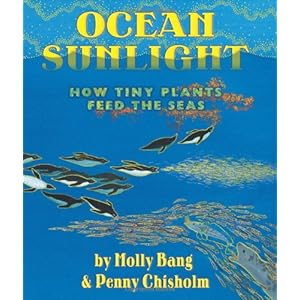However, sometimes I wonder just how much my children retain. Of course, I do not expect them to remember every little detail, but what do they remember of the unit?
It has been months since we even discussed the ocean unit. I thought it might come up during a recent trip to the beach, but the children were fascinated with the gulls and a little lizard we found. It did not bother me. We were at the beach to relax and have family time. Any learning and observing was definitely unstructured and unplanned. However, while visiting the library, I stumbled upon a new book called Ocean Sunlight: How Tiny Plants Feed the Seas, by Molly Band & Penny Chisholm. It seemed like it might be good as a review for the children.
What a find it was! This book, had it been published and available during our unit, would have been a great resource. The entire book travels through an oceanic food web starting with the sun rays reaching earth. The cycle continues all the way through the ocean even down to the twilight zone. The engaging text draws the reader along the energy paths. It ends with a message about the importance of the sun in sustaining life in the ocean.
Overall, the book is fabulous. It is informative without being dry and dull. The amount of text on each page makes it an easy book to read, and the illustrations are vibrant and interesting.
The only minor issue I have with the text is the way the author refers to humans as animals in the beginning of the book. "Animals - yes, animals like YOU! - eat the plants,..." This wording I changed to Animals and humans eat the plants. It is a small distinction, and some might not even find it necessary.
At the end of the book, a section of notes explains in detail some of the items mentioned in the text. Our children skipped this section. It didn't look as fun with all the text (two columns on each page!). However, for the parent, teacher, or interested child this section offers a lot more information. It does include a few paragraphs outlining evolutionary thoughts on phytoplankton. Honestly, this disappointed me. The book itself is solid in explaining a food web. Though I wasn't shocked to see it there, it really wasn't necessary to add the evolutionary topics. Despite my disappointment in this, I would still recommend this title to anyone studying oceanic life or food webs.
Are you designing or planning for your own ocean unit?
Perhaps a few of these past posts will help:
A Wet Lesson on Water
An Ocean Lesson
Water, Ocean, and Coral Reefs
Coral Reef Dioramas
A Trip to the Aquarium



No comments:
Post a Comment